Last Updated on April 4, 2024
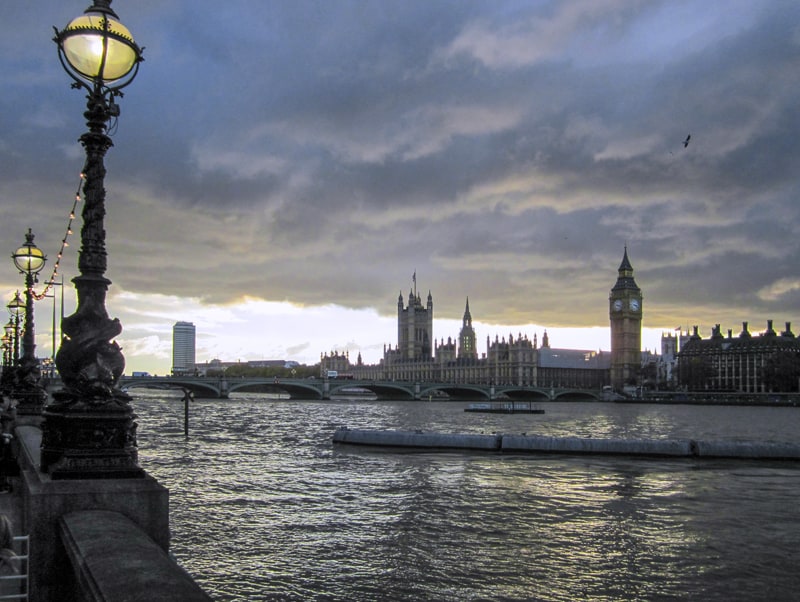
By Jim Ferri
Fall is a great time to travel in Europe, North America and northern Asia.
The weather is often wonderful, the tourist crowds have diminished and, hopefully, prices have edged down a bit.
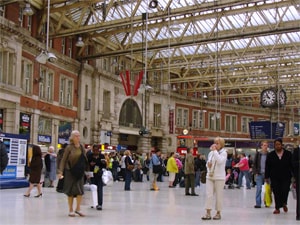
I was in London on one of those Fall days and I was looking for something to do. It was a beautiful October Sunday afternoon and, after giving it some thought, I decided to just take a walk. Not just any walk. The point wasn’t exercise; it was to see what I’d discover along the way.
At the time, I was at Waterloo Station, so I knew it would have to start somewhere close. I thought for a few minutes and decided to take a walk along the Thames.
Like most visitors to London, I had crossed the Thames many times while skirting about the city. But this afternoon, on my walk along the Thames, the river was to be my destination.
I’d pick starting and ending points and see what I’d happen upon during a casual stroll.
London is a perfect city for such ambling. It’s so perfect, in fact, that afternoon turned out to be more of an adventure than I expected.
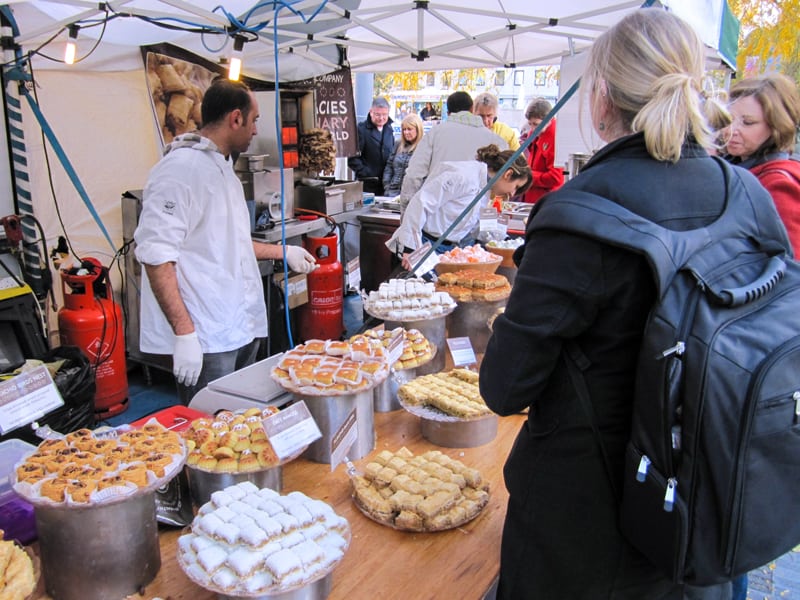
Starting My Walk Along the Thames
Glancing at a map, I saw the best starting point would be Waterloo Bridge, just a short walk away from the station. From there I could walk upstream along the south bank of the Thames on the Queen’s Walk. My destination would be the Houses of Parliament on the north side of the river.
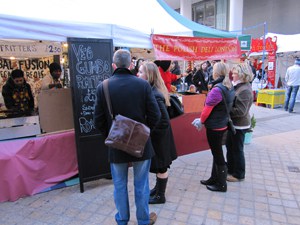
I estimated it would be a half-hour or so walk, which would leave plenty of time to dawdle along the way.
I set off for the bridge.
As I neared the bridge and the Thames, I found myself in the performing arts showcase of London. To my right was the National Theatre, which hosts everything from new plays to classic Shakespeare in its three theaters.
To my left was the large Hayward Gallery, the hosting venue for major art exhibitions. Beyond the Hayward was the landmark Royal Festival Hall in the Southbank Centre.
Not wanting to cross the bridge, I followed my fellow pedestrians down a stairwell to the road below. I soon realized it was a convenient way to access the local neighborhood as well as the Queen’s Walk. The street ran behind the Hayward and the Southbank, and its intersecting streets provided easy access to the walk along the river.
Once off the stairs, within minutes I stumbled upon the Southbank Centre Food Market, a market with stalls where one could purchase street food, beer and cocktails. It was a great little place, jam-packed with food tents offering numerous different cuisines. Wandering about, I fought the temptation to get anything so I wouldn’t ruin my appetite for dinner. But I succumbed when I caught the aroma of sausage and fried onions wafting through the crowd. (By the way, in several European cities there are upscale food markets where you can dine on regional foods.)
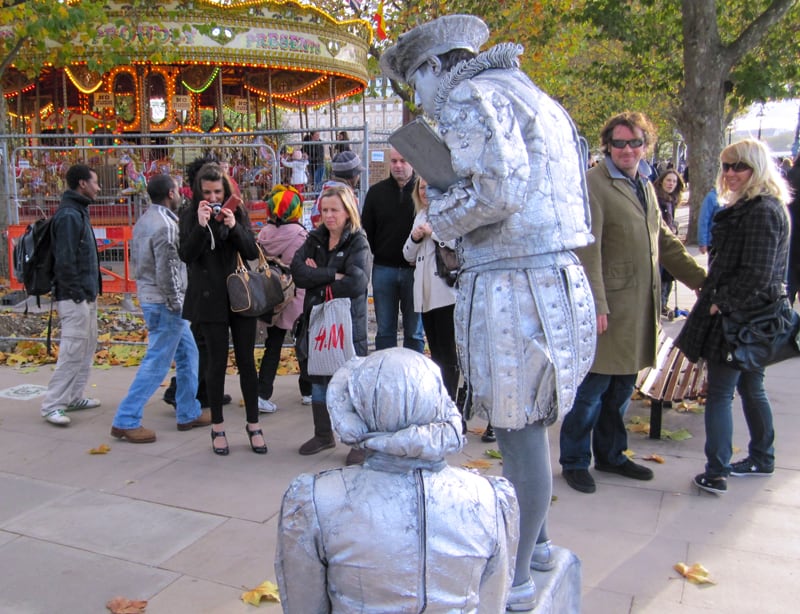
Wonderful Jubilee Gardens
After about a half-hour, I left the food tents and walked over to the Queen’s Walk.
Near here, on the embankment, is the Old Hungerford Bridge, flanked on both sides by the Golden Jubilee Bridges. Although the Jubilee walkways provide beautiful views, I didn’t take the bridges but instead turned up-stream.
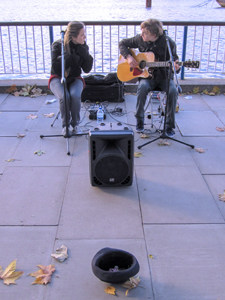
On my walk along the Thames I had a beautiful view of Big Ben and the Houses of Parliament in the distance. And within minutes I was at Jubilee Gardens, a small riverside park.
The park was laid out in 1977 to celebrate the Silver Jubilee of Queen Elizabeth II. It’s a wonderful, landscaped park, perfect for picnicking or, as many were doing, just relaxing on a sunny Sunday afternoon.
My walk along the river had been quite serene until this point. At the Gardens, however, the walkway expanded, providing plenty of space for numerous mimes, street-corner musicians, and other local entertainers.
Across the Thames, on the Parliament side of the river, I often felt myself immersed in history. Now, on the south side, I felt I was in Vaudeville. I passed Spiderman, Charlie Chaplin and many other mimes, including one who left me mystified as to what he was.
In the shadow of the London Eye, and before the backdrop of historic London on the other side of the Thames, I watched children playing, lovers walking hand-in-hand, parents taking photos of their children.
I spent some time there, especially watching the mimes interacting with passersby, just wandering about and taking it all in.
If You Go:
Jubilee Gardens
Note: the closest tube station for Jubilee Gardens is Waterloo. The tube stations Embankment, Westminster, Lambeth North, Waterloo East and Southwark are all within walking distance.
Admission: free
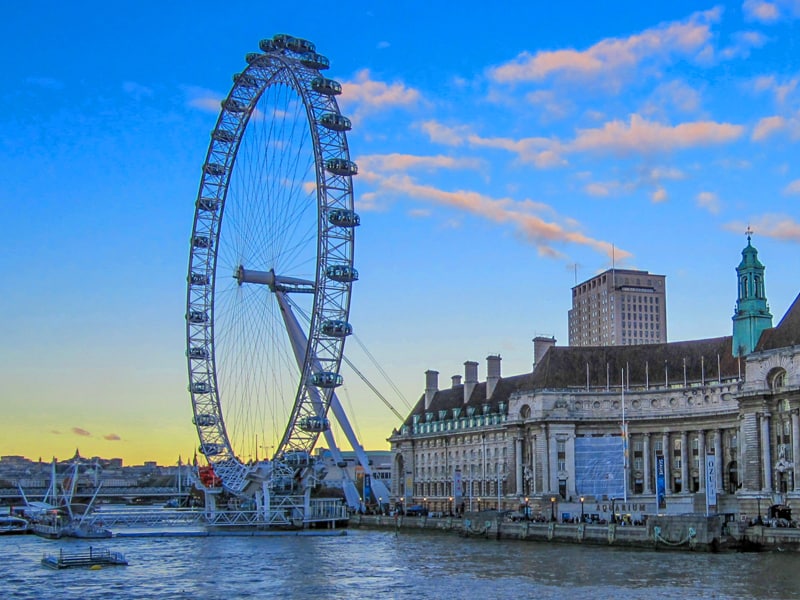
On a Walk Along the Thames, Don’t Miss the London Eye
Adjacent to Jubilee is the gargantuan London Eye. It’s the most popular tourist attraction in the United Kingdom for which an admission fee is charged. (See fares below). 3 million people who ride it every year can attest to its popularity.
For statisticians, it’s 443 feet (135m) tall, making it Europe’s tallest cantilevered observation wheel. It’s also 394 feet (120 m) in diameter. Its 32 cabins correspond to the 32 boroughs (not including the City of London) that constitute Greater London. And, since it only makes two revolutions per hour, it doesn’t need to stop for boarding/disembarkation of passengers. The exception, of course, is for passengers with disabilities.
Originally called the Millennium Wheel, I found it astounding that it was originally built to be operated for only five years. But it became so popular it’s become a permanent fixture on the Thames riverfront.
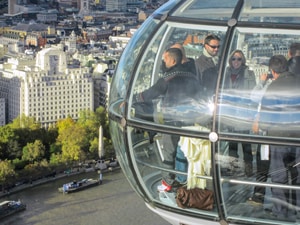
I’ve never enjoyed Ferris wheels or heights very much and hadn’t planned on taking the ride. But once I got a close-up look at the Eye, I headed for the ticket booth.
Although the line on the ramp looked quite long it moved quickly. In fact, after just 10-15 minutes, I boarded the capsule with a half-dozen others. The enclosed cabin was quite large – it can hold 25 passengers – with plenty of room to move about.
As it moved slowly upward, I was surprised that I was entirely anxiety free. In fact, it was a great leisurely ride, which provided the most incredible birds-eye view of the Thames and the city. If you go to London, take the ride.
(If you’re an acrophobic, you may want to opt instead for the London Eye River Cruise. Departing from the London Eye, it’s a 40-minute Thames circular-sightseeing tour highlighting some of the city’s famous landmarks.)
Back down on ground I joined the minions in the “official London Eye shop.” There one can purchase everything from coffee mugs and t-shirts to London Eye yo-yos and coasters. You’ll even find photos of yourself, taken while you were in the Capsule. But if you want one, you’ll need to have your capsule number to help you locate yourself among the multitudes. As might be expected, few things in the shop are inexpensive.
If You Go:
The London Eye
Riverside Building, County Hall
Westminster Bridge Road
London
Tel: 0207 967 8021
Admission: the standard adult ticket (online) is £31, although there are many package rates
Open: 11am – 6pm
London Eye River Cruise
https://www.londoneye.com/tickets-and-prices/general-tickets/river-cruise/
Admission: the standard adult ticket (online) is £31, a per-person family ticket £28
Open: 10:45am – 4:45pm
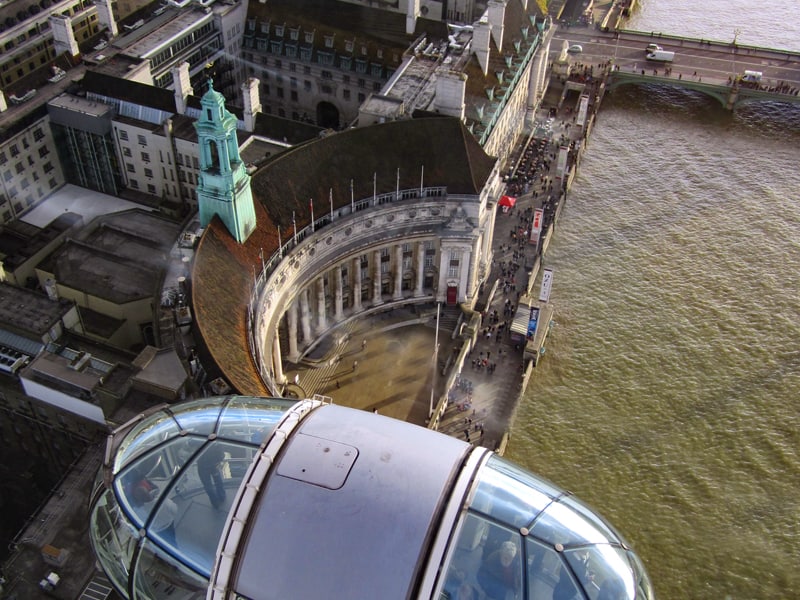
Other Eye-Openers, on a Walk Across the Thames
London Eye’s ticket office is in the former County Hall building along with the London Aquarium and the London Dungeon. In addition, in the building there’s also a leisure complex, two hotels and a few restaurants.
The aquarium, officially the SEA LIFE London Aquarium, is an exploration of the marine world with about 30,000 marine animals. One of its popular exhibits is a glass tunnel around which fish swim atop a recreated seabed. There’s also Seahorse Kingdom, the Rainforest Adventure (where you’ll see piranhas and crocodiles), Coral Kingdom, and Shark Walk. About a million visitors a year spend 1-2 hours here on their visit.
You may also enjoy: Museums in South Kensington, London’s Unique Treasures / London’s Incredible Sir John Soane’s Museum / Best Things to Do in London in Winter (or Any Time of Year) / Easy Day Trips From London.
A few minutes’ walk away is the London Dungeon. It’s popular with children, as might be expected, since recreates some of the most gruesome events in British history. With actors, special effects, and a dollop of humor, it produces plenty of screams from kids as well as adults. Think Jack the Ripper, the Torture Chamber, the Great Plague, etc.
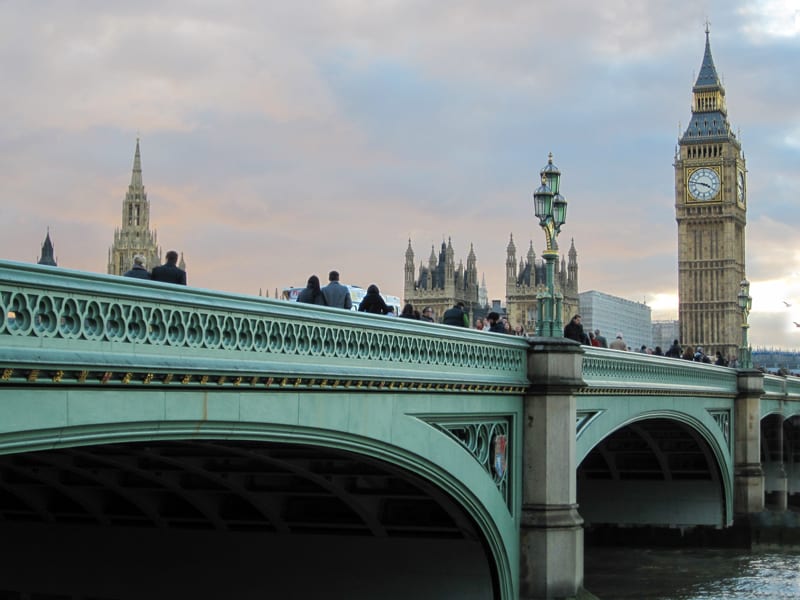
Westminster Bridge
When you exit the London Eye or the County Hall building, you’re quite close to Westminster Bridge. In fact, the bridge is adjacent to the County Hall. Cross it and you’ll wind up at Big Ben.
Instead of immediately crossing the river, however, I decided to relax on one of the riverside benches. It was a great place to take in the scene and absorb the incredible panorama before me.
After a short while, the afternoon light began to wane and dark clouds began to drift across London. It was the Thames at its dramatic best and a beautiful sight. I watched as the changing light and gathering clouds gave everything along both sides of the river an ethereal effect.
After a while I walked over to the bridge to continue back to my hotel. As Big Ben struck the hour, I looked up at a sky that had turned a beautiful pinkish grey.
For a few moments I was oblivious to the people and traffic about me, feeling as if I had stepped into a J.M.W. Turner masterpiece. On the Westminster Bridge that afternoon, Britain’s celebrated “painter of light” seemed all about me…

I enjoyed this great story describing your amble around in London seeing what you can find…and doing some of the things, such as the London Eye. Fun reading!
Thank you Carla! It’s a great walk for the entire family, although it could get expensive if you delve into everything.